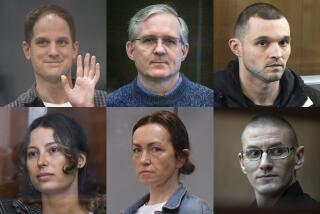Only Sign of Soviet Acceptance of U.S. Aid : UCLA Specialist on Way to Help Victims
- Share via
Responding to a Soviet invitation, an American physician who heads an international registry of bone marrow centers flew to Moscow on Thursday to help evaluate victims of the Chernobyl nuclear disaster.
The personal invitation to Dr. Robert P. Gale of UCLA was the first and only sign of Moscow’s willingness to receive U.S. assistance in the wake of the nuclear power accident.
The genesis of Gale’s trip occurred on Tuesday in Washington when Los Angeles industrialist Armand Hammer visited the Soviet Embassy and told Oleg M. Sokolov, the Soviet charge d’ affaires, about the existence of up to 75,000 potential donors in the United States, Britain and Scandinavia.
In an interview before he left for Moscow on Thursday afternoon, Gale said the Soviets did not specify to him what their medical problems or needs are. They asked him to come alone. Gale is a marrow transplant expert who chairs the International Bone Marrow Transplant Registry.
Severe radiation exposure can destroy bone marrow, where many components of blood and the immune system are produced. In some cases, such victims can be treated by healthy bone marrow from unexposed donors--if the transplants are done quickly, because death occurs within about two weeks after a lethal dose.
Gale’s trip to Moscow came only hours after the Soviet Union had officially rejected an offer of humanitarian and technical help from President Reagan. “They did reply that they appreciated the effort, and they do not sense any need for it at this point,” Secretary of State George P. Shultz told reporters traveling with the President in Bali, Indonesia.
And only on Wednesday, the Soviet co-president of the anti-nuclear doctors group that won the 1985 Nobel Peace Prize declined an offer from his U.S. counterpart to provide medical assistance to Chernobyl’s victims. Dr. Yevgeny I. Chazov, in a telex on Wednesday to the American co-president of the International Physicians for Prevention of Nuclear War, Dr. Bernard Lown of Harvard, said: “All questions are being effectively resolved and at the moment there is no need of help on behalf of the international medical community.”
Medical experts said the extent of the Soviet capability to do bone marrow transplants is unknown here. They said the Soviet Union does not belong to the bone marrow registry, and its scientists do not attend the meetings at which Western scientists present scientific reports.
U.S. scientists also said they do not know the extent to which the Soviets have compiled lists of persons--relatives of nuclear plant workers, for example--who have been tissue-typed and are readily available to become donors. As with blood donations, bone marrows must be matched for compatibility between donor and recipient, a process called tissue-typing.
The donor pool that Gale said would be made available to the Soviets consists of volunteers who have agreed to donate marrow in the event of medical emergencies.
Costly Operation
In a telephone interview Thursday, Hammer, who is chairman of Occidental Petroleum Corp. and who has had a long personal relationship with Soviet leaders, said that Paul Terasaki, an internationally known expert on tissue-typing at UCLA, has agreed to follow Gale to the Soviet Union to set up a tissue-typing laboratory, if one is needed.
Hammer, who financed Gale’s trip, said he volunteered to pay for the transplants, but he said the Soviets turned him down. In the United States, each marrow transplant costs about $100,000.
Dr. Mortimer Bortin, scientific director of the International Bone Marrow Transplant Registry located in Milwaukee, said in a telephone interview that he is alerting bone marrow transplant teams who may be called upon to go to the Soviet Union.
Donors themselves would only have to go to a regional center in their own countries, where their marrow would be extracted and then frozen for shipment by air to the Soviet Union.
Bortin said that Poland, Hungary and Yugoslavia are among the Eastern Bloc countries that have bone marrow centers that belong to the international registry, where the transplantations could take place if suitable facilities are unavailable in the Soviet Union.
If donors from outside the Soviet Union are needed, Dr. John Hansen of the University of Washington’s Fred Hutchinson Cancer Research Center has been designated to coordinate the mobilization of such donors.
But Hansen was skeptical about the success in finding donors for all victims if a large number require transplants.
Because donors from outside the Soviet Union would be unrelated to the accident victims, it would be more difficult to find donors whose tissue types match the recipients. Bone marrow transplants have much greater success when donors and recipients are related.
The reason, Hansen said, is that a large variety of tissue types exists. He said the problem is even more complex when two different populations are involved--Ukrainian victims and Scandinavian donors, for example.
“If we try to get matches for Ukrainians, we might have difficulty getting matches from Northern Europe,” the physician said.
More to Read
Sign up for Essential California
The most important California stories and recommendations in your inbox every morning.
You may occasionally receive promotional content from the Los Angeles Times.













